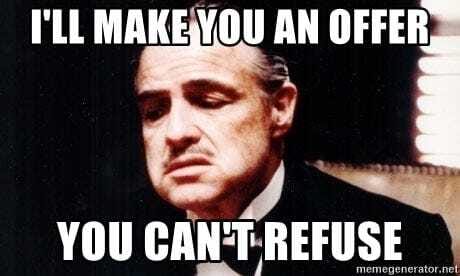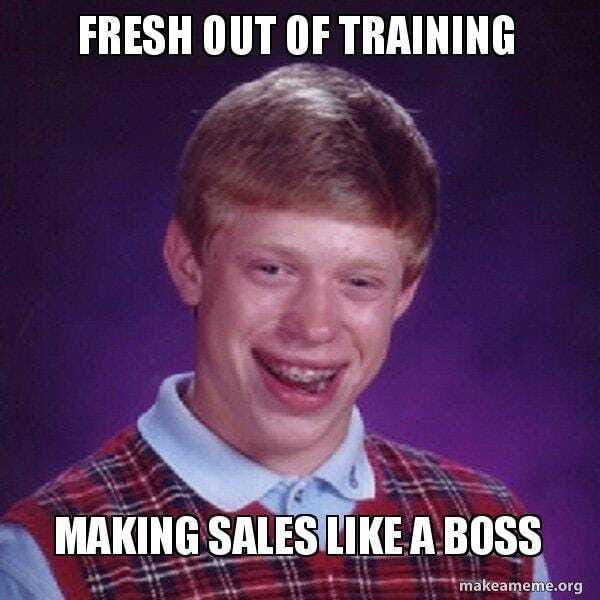- Conquer Sales Newsletter
- Posts
- #7 A Sales Process in 10 Steps
#7 A Sales Process in 10 Steps
A sales process should be measurable, scalable and repeatable
Often people look at me wide-eyed when I tell them I help companies revamp their sales process.
What does it mean? A process? Yuk.
If you have a business, you have a sales process. You just don’t call it that, it’s probably just “there”, more intuitive than structured.
Call it a system if you prefer. A succession of steps that builds towards a given outcome: winning that deal and gaining a new customer.

Building a sales process is critical to the success of any business, regardless of its size or industry.
A sales process is a repeatable series of steps that a sales team takes to
identify,
qualify, and
close deals with potential customers.
A well-designed sales process can help a business
increase their sales efficiency,
improve their win rates, and
ultimately drive revenue growth.
In this edition of Conquer Sales, we'll take a detailed look at the key components of a successful sales process and provide practical tips and best practices for building one that works for your business.
Why a Sales Process Matters?
Before we dive into the specifics of how to build a sales process, it's worth taking a moment to consider why it matters in the first place.

There are several key reasons why having a well-designed sales process is critical to success:
Improved efficiency: clear steps to follow helps improve efficiency and reduce wasted time and effort.
Better qualification: a well-designed sales process can helps to more effectively qualify potential leads, which can help to improve win rates and reduce churn.
Better forecasting: by tracking and measuring key metrics throughout the process, you can develop more accurate sales forecasts and improve your ability to plan for the future.
Increased revenue: by streamlining the sales process and improving win rates, you can ultimately drive revenue growth and increase profitability.
Key Components of a Sales Process
So what are the key components of a successful sales process? While there is no one-size-fits-all answer to this question, most successful sales processes share a few key characteristics, including:
1. Lead generation
The first step in any sales process is “leadgen”, which involves identifying potential customers who may be interested in your product or service.
How to generate leads?
Inbound: A longer-term strategy built around creating high-quality content (blog or social media), SEO optimisation and targeted advertising campaigns.
Outbound: Cold calling, cold emailing, LinkedIn outreach (or any other network for that matter) can all be effective ways to generate leads. A usually effective short-term strategy (as opposed to Inbound) but more resource-intensive than inbound strategies.
Referrals and networking: Asking existing customers for referrals and attending events can help to build your network and generate new leads through word-of-mouth.
Tools that can help for leadgen:
Making sure you have several ways of reaching out to clients is key so finding their email and phone number can be a big plus. You can use Apollo or Dropcontact to enrich your data and even use Humantic AI to learn more about their personality (scary) to go down the rabbit hole of extreme personalisation!
2. Lead qualification
Once you have generated a list of potential leads, the next step is to qualify them to determine whether they are a good fit for your product or service. Qualification typically involves evaluating factors such as:
Budget: Does the potential customer have the budget to afford your product or service?
Authority: Does the potential customer have the authority to make purchasing decisions, or will they need to consult with other stakeholders?
Need: Does the potential customer have a demonstrated need for your product or service?
Timing: Is the potential customer looking to make a purchasing decision in the near future, or is their interest more long-term?
Be clear with your prospect that you’ll have x amount of qualifying questions that you need to go through before you move on to focusing on the prospect and his needs.

Tools that can help for qualifying:
Depending on your company size, volume of inbound leads, etc… you might want to consider a form to weed out those that are not qualified or gather some initial information to make the call more meaningful for them. You could try Tally (great free plan) or more known Typeform. Want to take it to the next level? Try VideoAsk to make it interactive and personable.
3. Discovery / Needs analysis
Once a lead has been qualified, the next step is to conduct a needs analysis to better understand their specific challenges and needs.
This typically involves gathering information within discovery calls and using that information to develop a customised solution that meets the customer's needs.
I’ve touched on discovery calls in a previous edition if you want to learn more.
Tools that can help with discovery:
We should focus on the prospect so recording, transcribing and even summarising the call can be a life saver. Not just for the above reason but to later review and even collect the best calls for coaching.
I’ve tried a few tools: If you’re a Zoom user Fathom is a free tool but only supports Zoom. If you don’t use Zoom, go for tl;dv’s simplicity (great free plan).
In the race to consolidate tools, I found one that goes beyond and combines the above capabilities along with asynchronous recording (I was using Loom). It’s called Claap and it’s my current favourite. I like it so much I asked them how I could share it and they gave me a 20% off code CEDRIC_CxCLAAP if the generous free plan isn’t enough for you. Enjoy.
4. Proposal
Based on the needs analysis, you should then develop a tailored proposal that outlines how your product or service can help to solve the customer's specific challenge.
This proposal should be tailored to the customer's specific needs and should clearly outline the value proposition of the product or service.

Tools that can help with proposal and e-signature:
Again, there are many tools to choose from. I’ve been using Pandadoc (get in touch for better pricing) recently and have been looking into Better Proposals as well.
5. Objection handling
Even if you have prepared a great proposal, prospects will most probably still have objections.
I’ve done a whole article on handling objections which I invite you to check out later.
Some high level tips include:
Acknowledge the objection: and show that you understand their point of view.
Address the objection: by asking further questions to make sure you fully understand the objection.
6. Closing the Sales
The final stage. Sort of.
Your prospect agrees to move forward.
This stage requires finesse, as it involves negotiating terms and price, handling objections, and ensuring that the customer is happy with the proposed solution.
To effectively close a sale, it is important to understand the prospect's buying process and decision-making criteria.
That way you can tailor your approach to meet their needs and address any concerns they may have.
7. Post-Sale Follow-Up
Once you’ve closed the sale, the sales process is not over.
Post-sale follow-up is a critical component of building a strong customer relationship and already contributes towards you’re retention strategy.
Make sure the customer is satisfied with their purchase, address any concerns they may have, and provide ongoing support as needed.
If you have them in your team, you probably involved an Account Manager earlier in the process so this is just making sure the handover is done properly.
Regular check-ins and proactive communication can help build trust and establish a long-term relationship.

Continue to provide value through additional products or services that may be of interest to the customer.
8. Key Metrics to Track
Remember the subtitle of this edition? A sales process needs to be measurable (as well as scalable and repeatable).
To measure the success of your sales process, you need to track key metrics such as:
Lead generation: the number of leads generated through the various channels.
Conversion rate: the percentage of leads that turn into customers.
Sales cycle length: the amount of time it takes to close a sale.
Average deal size: the average value of a closed deal
Customer acquisition cost (CAC): the cost of acquiring a new customer, including marketing and sales expenses.
Sales velocity: the rate at which leads move through the sales process
Lifetime value (LTV): the total amount of revenue a customer generates over the course of their relationship with the business.
Sales pipeline: The number and value of opportunities in the sales pipeline, as well as their stage in the sales process.
By tracking these simple metrics, you can already identify areas for improvement and optimise your process for better results.
9. Refine and Optimise
Building a successful sales process is an iterative process.
As you start implementing your process and tracking your metrics, you’ll start to identify areas for improvement.
Maybe your conversion rate is lower than you’d like, or your sales cycle is taking longer than expected. These insights are opportunities to refine and optimise your sales process to achieve better results.
Continuously test and refine your sales process to improve results. Some areas to focus on might include:
Refining your messaging and value proposition to better resonate with your target audience
Optimising your prospecting process to improve the quality of leads you’re reaching out to (tools like Sales Navigator come to mind… use it properly)
Improving your sales pitch and objection handling to increase conversion rates
Streamlining your sales process to reduce the length of your sales cycle and improve sales velocity
10. Upskill and Coach Your Sales Team
Your sales process is only as effective as the people who execute it.
Continuously train and develop your sales team to ensure they have the skills and knowledge they need to be successful.
Invest in ongoing training, coaching and development for them. This might include:
Sales training to improve core skills like objection handling, negotiation, and closing
Product training to ensure your sales team has a deep understanding of your offerings
Industry training to keep your sales team up-to-date with industry trends and developments
By investing in your sales team’s development, you can improve the effectiveness of your sales process and drive better results.

Conclusion
To build a successful sales process, consider the following best practices:
Understand your target audience: Develop a deep understanding of your target audience's needs, challenges, and decision-making criteria.
Develop a clear value proposition: Communicate the value of your solution clearly and concisely, and demonstrate how it addresses your target audience's pain points.
Invest in lead generation: Develop a multi-channel lead generation strategy that targets your ideal customer profile.
Qualify leads effectively: Develop a clear qualification criteria and use it to identify high-quality leads that are most likely to convert.
Build a sales pipeline: Use a CRM to track and manage opportunities throughout the sales process, and prioritise leads based on their stage in the pipeline.
Follow up consistently: Regularly follow up with leads and customers to build trust and establish long-term relationships.
Continuously improve: Use data and metrics to identify areas for improvement and optimise your sales process over time.
Building a successful sales process is key to driving revenue growth and building a sustainable business.
By following these steps, you can create a sales process that’s tailored to your business and helps you achieve your sales goals.
Remember, building a successful sales process is an iterative process, so don’t be afraid to test and refine as you go. With a strong sales process in place and a dedicated team executing it, you can drive long-term success for your business.
Reply